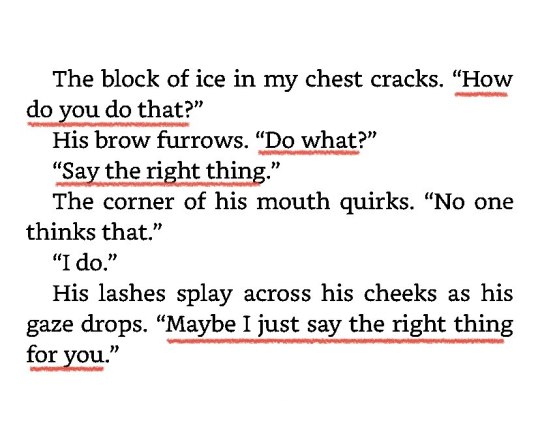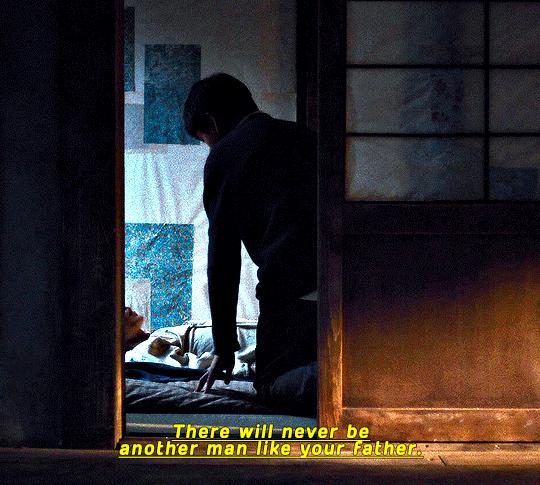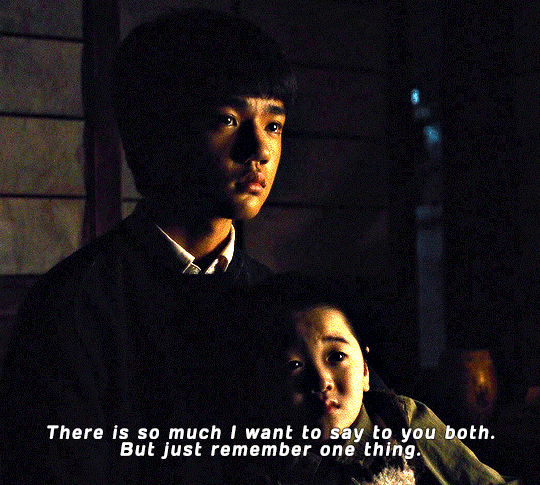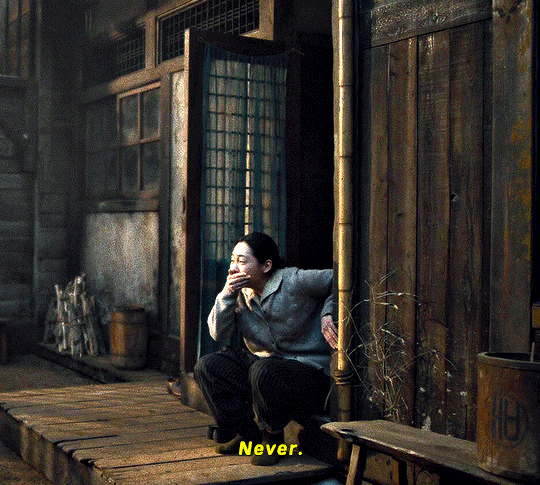|| a reckless ex-dreamer || seeking for true love || #bibliophile || #movieBuff || #TvSeriesJunkie
Don't wanna be here? Send us removal request.
Text
“Now you’re being ridiculous,” he says. “When I’m not at work, I’m in my coffin in the basement of an old Victorian mansion.”
Book Lovers - Emily Henry






#charlie lastra#book quotes#banter#emily henry#love#nora stepehens#charlie x nora#book lovers#bill skarsgard#romcom#bill#skarsgard
13 notes
·
View notes
Text
charlie lastra never had a bad track. "or maybe, nora stephens, I can read you like a book” BANGER “you do have me, nora. I never stood a chance” LIFE CHANGING “if you’re the wrong kind of woman, then I’m the wrong kind of man” SHOWSTOPPING “and then you showed up and I could finally breathe” ICONIC “there’s just tall women, and the men too insecure to date them” REVOLUTIONARY
76 notes
·
View notes
Text

Shop , Patreon , Books and Cards , Mailing List
9K notes
·
View notes
Text
“Stephens,” he says, tone dry once more, “if you’re the villain in someone else’s love story, then I’m the devil.”
Book lovers - Emily Henry


#book quotes#amreading#banter#book lovers#emily henry#bill skarsgård#samara weaving#charlie lastra#nora stepehens#charlie x nora
4 notes
·
View notes
Text
“Yeah, Heathcliff is trash, but he’s my trash.”
—Catherine Earnshaw, probably
115 notes
·
View notes
Text
Understanding “Wuthering Heights” inspiration in “Nosferatu” (2024)
Did anyone ordered the horror version of “Wuthering Heights”? Because Robert Eggers delivered.
Ellen and Orlok are toxic as hell; this should go without saying. Their whole deal is about pure obsession, persecution, sex and death. It’s a blend of hatred and passion, all consuming and self-destructive, inspired by Catherine and Heathcliff from Emily Brontë’s “Wuthering Heights” as confirmed by Robert Eggers. Orlok both disgusts and attracts Ellen. It’s “unhealthy and parasitic form of love” and there’s a “mutual yearning” between these characters, and a love triangle with Thomas, like Lily-Rose Depp says, as Ellen is in love with them both:
“This demonic, dark fairy tale could be a young woman torn between two men, both representing different parts of what she wants. The desire and disgust serves as a mirror for the shame that we feel, certainly the shame that I’m sure a lot of women felt at the time.”
We are also told Ellen both hates and enjoys her psychosexual connection (dreams, possession, etc.) with Orlok, being riddled with guilt and shame, due to Victorian views of sex (as Lily-Rose Depp explains).
Catherine and Heathcliff from “Wuthering Heights” are one of the darkest pairs in English literature, and even Robert Eggers call them “one of the great demon lover stories of all time”, and how the reader is always wondering about the ambiguity of Heathcliff’s feelings for Catherine, if he loves her or not, if he wants to possess or to destroy her. Robert Eggers also said he returned to “Wuthering Heights” a lot while writing “Nosferatu” script.
“At first it was sweet, I had never known such bliss. Yet it turned to torture, it would kill me. […] He is my shame! He is my melancholy! He took me as his lover then, and now he has come back. He discovered our marriage and has come back!”

“Wuthering Heights” (2011)
How deep does this inspiration runs in the film? Can it help us to understand Ellen and Orlok’s dynamic? And the love triangle with Thomas? And even the ending?
This “ambiguity” also seems to be Eggers’ goal with Ellen and Orlok’s relationship on his adaptation of “Nosferatu”: the dialogue shows the hatred, while the love is represented in the symbolism of the lilacs, and the lust/passion with their body language.
We have some interesting references to Catherine on Ellen’s backstory (when she talks to Von Franz); she liked playing in the woods as a child, and her father called her “his little changeling girl” (as in the European folklore of children kidnapped by fairies or demons and a substitute being left in their place), implying she was mischievous and wild, like Catherine herself. In her teenage years, like Catherine, she develops an intense, passionate and secret relationship with Orlok/Heathcliff. While Catherine and Heathcliff had the moors, Ellen and Orlok had a garden of lilacs (according to the prologue, and since we have no other indication, let’s assume that was their usual “meeting spot”).
In both cases, these relationships are socially inappropriate and sort of forbidden (Heathcliff’s ethnicity and poverty; and Orlok is a undead demon vampire), and they would make Ellen/Catherine into a social pariah, dead to society (in Ellen’s case, literally) should they commit to it. Which is why they don’t, and choose Edgar/Thomas instead.


“Wuthering Heights” (1992)
Ellen’s wild and passionate affair with Orlok came to an end when she met and married Thomas Hutter; like Catherine and Heathcliff when she met Edgar Linton. Both Thomas and Edgar are gentlemen, graceful and well-mannered, embodied with civilized virtues. Catherine loves Edgar because he’s handsome, young, cheerful and rich, and marries him to fulfill societal expectations, but her love for Heathcliff is ever present, haunting and tormenting her.
I’ll add a personal note here: while I loved “Nosferatu”, I think the previous relationship between Ellen and Orlok should have been more fleshed-out on-screen, during the prologue. Because the entire story feels a bit contrived due to that lack of context. We only saw her summoning him and when he revealed himself to her, and the rest of the clues about their shared past are all over the place, and are causing a lot of misunderstanding on the audience. Eggers probably didn’t want to “humanize” his monster too much and keep the horror element, but the message gets a bit “lost on translation”.
Why does Ellen loves Thomas? She says to Von Franz she became “as normal” when she met him, and we have several mentions of how his love saves her. He represents her chance at a normal life (societal expectations), and she sees him as her savior. In a way, Catherine also saw Edgar as her “savior” from a life of poverty, the life she would have had if she married Heathcliff, even though she considers him her soulmate. Ellen’s “epilepsies” stopped when she met Thomas; as Catherine also loses her “wild ways” when she meets Edgar. Nevertheless, Orlok’s memory is always haunting her (like Catherine with Heathcliff), as symbolized by the lilacs on her wedding outfit, her gowns, and even her perfume.
Thomas also shares similar traits with Edgar: kind, polite, loyal and is a good and supportive husband to Ellen/Catherine, even though they don’t fully understand their emotional turmoil/darkness, they stand by them. Both characters have a gentle and nurturing nature, and try to provide Ellen/Catherine with a comfortable and stable life. While Edgar is rich, Thomas is hard-working. They will both be grieving widowers. Like Edgar, Thomas is the antithesis to Orlok/Heathcliff in this story. Edgar is a model of tenderness and constancy, like Thomas himself; while Heathcliff/Orlok are the complete opposite.
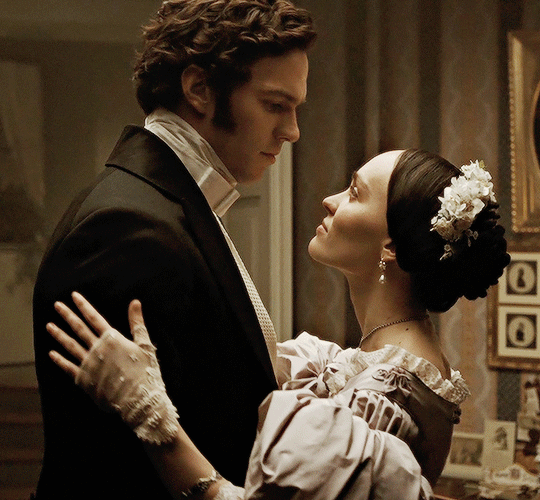

“Wuthering Heights” (Minisseries, 2009)
Like Catherine and Edgar, Thomas and Ellen’s love is marked by kindness, and a desire for stability, but is always haunted by Orlok/Heathcliff passionate and destructive love/obsession. In both stories, this leads to tragedy, suffering and emotional pain for the three characters.
In her heart, Catherine wants to be with Heathcliff, but her mind tells her she must marry Edgar. She’s deeply conflicted about the whole ordeal, torn between her love for two men, and her own nature vs. social expectations of her. This is also what we see with Ellen, when she tells Thomas about her dream of marrying Death (Orlok) on their wedding day. And how she has never been so happy in her entire life as in that moment. And the scent of lilacs was strong in the rain, symbolizing her connection with Orlok.

Both Orlok and Heathcliff become obsessed in getting revenge for the way Ellen/Catherine left them, planning their entire existences around the goal of destroying Catherine and Edgar’s families, after he returns to Wuthering Heights. Which is, pretty much, what Orlok does in “Nosferatu”, by targeting Thomas and the Hardings. Heathcliff violent, bitter and vengeful nature is revealed in this plot, and he’s ruthless and merciless.
Which, again, is very similar to Orlok’s actions in Wisburg (even thought they were already a part of the original story, Eggers gave it a new layer of intention). However, and even though he feels deeply betrayed by Ellen, Orlok (like Heathcliff) never targets her, directly, but wants to torment her by destroying her loved ones, as revenge for leaving him and marrying Thomas/Edgar instead. "You are my affliction", says Orlok. Of course, this is taken to an extreme on “Nosferatu” because it’s a horror film.

“You teach me now how cruel you've been - cruel and false. Why did you despise me? Why did you betray your own heart, Cathy? I have not one word of comfort - you deserve this."
Once he returns to Wuthering Heights, Heathcliff visits Catherine and Edgar’s house often, and Catherine herself can’t take her eyes off him; which parallels Ellen’s “hysteric fits” in “Nosferatu”; as Orlok coming between Ellen and Thomas. Like Catherine, Ellen is also distress by these visits (“epilepsies”) but finds it extremely hard to resist engaging with Heathcliff/Orlok: “his pull on me is so terrible, so strong”. Catherine and Heathcliff’s separation did not change their feelings and they yearn for each other even more; in “Nosferatu” this is visible in Ellen and Orlok’s body language.

“You loved me then, what right had you to leave me? What right, answer me, for the poor fancy you felt for Linton? Because misery and degradation, and death, and nothing that God or Satan could inflict would have parted us, you, of your own will, did it. I have not broken your heart, you have broken it; and in breaking it, you have broken mine.”
When Edgar realizes the depth of Heathcliff’s influence on Catherine, he feels threatened, insecure and jealous. We see this on “Nosferatu” when Thomas has sex with Ellen after she tells him “you could never please me as he could”, as he gets insanely jealous of her words. This scene is also a reference to Catherine weaponizing Edgar and Heathcliff jealousy against each other; when she taunts Edgar for being weaker than Heathcliff, and rubs her marital happiness on Heathcliff’s face (we see this when Ellen tells Thomas to let Orlok see their love).
Like Edgar, Thomas also loves Ellen, deeply, but her “divided affections” cause him emotional pain and frustration, especially as Ellen/Catherine is drawn back to Orlok/Heathcliff: “Stop this, Ellen! I love you!” Even when Ellen’s connection with Orlok consumes her, Thomas remains loyal to her, like Edgar with Catherine. In “Nosferatu” we don’t know, but in “Wuthering Heights”, Edgar buries Catherine on the moors, after her death, and then has himself buried next to her, decades later, instead of his family crypt.

“Heathcliff would as soon lift a finger at you as the king would march his army against a colony of mice.”
We also see the rivalry between Thomas and Orlok in “Nosferatu”. Like in the original “Dracula” novel, the Count lures him into a trap by making him travel to his castle, where he steals the silver heart locket Ellen gave him, and bitterly says to Thomas “you are fortunate in your love”. Orlok smelling the strand of Ellen’s hair is also a reference to when Heathcliff does the same to Catherine. And then tries to kill him, but he manages to escape. Like Heathcliff, Orlok also speaks ill of Thomas to Ellen herself, weaponizing his greed, while implying Thomas doesn’t really love her. Heathcliff also says Edgar just performs his duty, while he’s the one who truly loves Catherine.
Heathcliff and Edgar’s fights cause the deterioration of Catherine’s health until she locks herself in her room, spiraling down into delirium and depression, tormented by nightmares and hallucinations. Catherine’s madness appears to be the reference for Ellen’s mental condition in the film. Catherine is also distressed and protests over Edgar’s response to her illness (retreating to society and his library). In “Nosferatu”, we can see this with Ellen’s distress over Thomas leaving her, at the beginning of the film, as he dismisses her prophetic dreams as “fancies”.

“Because I'm weak, my brain got confused, and I screamed unconsciously. Don't say anything; but stay with me. I dread sleeping: my dreams appal me.”
Catherine’s madness is a combination of things we also see in Ellen’s character. At its core is Catherine obsessive, tumultuous and passionate connection with Heathcliff. We see this with Ellen and Orlok, and she calls him “her melancholy” and “her shame”, as they share a deep, sexual and spiritual bond. Like Catherine and Edgar, Ellen’s marriage to Thomas is rooted in security, stability and social respectability, and it should be everything she’s supposed to desire and aspire, but it’s unfulfilling and suppresses her true nature (in Ellen’s case it’s her supernatural abilities, and she also wishes Thomas was more passionate).
This is also align with Lily-Rose Depp words:
“I think in a lot of ways, he's [Orlok] almost a symbol of the things that you don't want or that you shouldn't want, and yet you are so drawn to. I think a lot of what Ellen is going through is an internal battle between all of this darkness that she's always had within her, and then the light that she's trying to cling to. I think he [Orlok], of course, is the manifestation of that, of that darkness. We definitely wanted it to feel like a love-triangle in a lot of ways and it's a love story in the end. I think she really loves Thomas and I think she does though have this twisted yearning for this darker realm, and I think [Orlok] is the embodiment of that.”
Catherine feels trapped by her life choices which are a consequence of Victorian society, which has strict expectations of women regarding marriage, class and behavior. Her all-consuming love for Heathcliff, her unfulfilling but agreeable marriage to Edgar and her identity crisis, create a profound internal conflict that lead her to her tragic decline and premature death, as a consequence of her depression.
Both men suffer deeply with her death; Edgar with calm sadness (which is what we see with Thomas at the end of “Nosferatu”) while Heathcliff is full desolation and anguish, begging for her ghost to haunt him as he begins a path of self-destruction. Catherine’s ghost indeed haunts Heathcliff for eighteen years, and we see a reference to this on “Nosferatu”, too, when Anna Harding tells her husband: “Clara asked me today if Aunty Ellen has become a ghost.”

“It would degrade me to marry Heathcliff now; so he shall never know how I love him: and that, not because he’s handsome, Nelly, but because he’s more myself than I am.”
Like Catherine, Ellen doesn’t reveal the depth of her feelings for Orlok/Heathcliff to him until the bitter end, nor any character in the story, besides Nelly and Von Franz (and even then is very cryptic, which makes the audience think she has none, and that’s why the lilacs are there). But both Orlok and Heathcliff are very much aware of them, as Heathcliff says “you know as well as I do, that for every thought she spends on Linton, she spends a thousand on me!”
Orlok: “Your passion is bound to me.” Ellen: “You cannot love.” Orlok: “I- cannot. Yet, I cannot be sated without you. Remember how once we were? A moment. Remember?” Ellen: “I abhor you.” Orlok: “You are false!” Alexa play “Wuthering Heights” by Kate Bush
Catherine loves Heathcliff because their souls are the same: “He's more myself than I am. Whatever our souls are made of, his and mine are the same.” In “Nosferatu”, this translates in the covenant between Orlok and Ellen: “As our spirits are one, so too shall be our flesh. You are mine.” They also share the same nature; when Ellen says she has felt Orlok crawling like a serpent on her body, he says it’s her own nature, a nature she denies (“you denied yourself”). And while Catherine loves Edgar, she recognizes their spirits are “as different as a moonbeam from lightning, or frost from fire”; which is the same with Thomas and Ellen, as he worries about money and social status, and she doesn’t, he’s more restrained in his affections, while Ellen is more passionate.
This is aligned with Robert Eggers explanation, and so, indeed, the “Wuthering Heights” inspiration is very clear in this story:
“Ellen’s husband loves her, but he can’t understand these ‘hysteric’ and ‘melancholic’ feelings she’s experiencing, and he’s dismissive of her. The only person she really finds a connection with is this monster, and that love triangle is so compelling to me, partially because of how tragic it is.”
Edgar/Thomas represents safety and social stability (society), while Heathcliff/Orlok embodies wild passion and freedom (nature) in Catherine and Ellen’s narratives. In Ellen’s case this is even more evident with the corset symbolism (restrictive and cagey); in every scene she has with Orlok, she never wears a corset, as she’s usually on her nightgown. The only exception is when she wears her wedding dress in their final scene, and even then, she ends up fully naked before him, fully liberated from social restraint, fully embracing her nature (which can also be a reference to Carl Jung’s “assimilation/integration of shadow” theory).
Eggers also makes the distinction between “love” and “passion” in his script; Thomas is “love” while Orlok is “passion”. This has occult meaning, but it can also be a way of showing to the audience this polarization/dichotomy in Ellen’s narrative. Because Ellen equals “love” with “sacred” and “salvation” in the script; while “passion” is “unclean” and “abhorrent”. Which is very much in line with Victorian views of sex (passion) and marriage (love); “passionate sex” is sin and unholy (demonic); while “marriage” is love sanctified by religion (sacred).
Ellen spent the second act of the movie talking about how Thomas love has “saved” her from her connection with Orlok, and on the third act is Thomas himself who wants to embody the “savior” role; as he’s determined to destroy Orlok, and then runs to try and save Ellen. But Ellen begins the third act by saying to Von Franz: “I need no salvation”, and how she has always been true to her own nature, as Von Franz asks her to be true by it now, because only her can redeem them. But Ellen accepting her true nature means accepting Orlok, because they are one spirit, like Catherine and Heathcliff.

“I am Heathcliff! He’s always, always in my mind-not as a pleasure to myself, but as my own being. So don't talk of our separation again - it is impracticable.”
But Catherine wants to “have her cake and eat it too”, by having both Edgar and Heathcliff in her life, until she’s faced with the impossibility of having both, and is forced to choose.
We also see this happening in “Nosferatu”, but, unlike the novel (where it’s Edgar who gives her an ultimatum), here it’s Orlok who forces Ellen/Catherine to choose between him or Thomas/Edgar. It wouldn’t make any sense to be Thomas, let’s be honest. In both cases, this is not really a choice, because Catherine choosing Heathcliff would mean leaving her husband, damaging her reputation beyond repair, and she would be ruined. It would be want we call “social suicide”, nowadays. Ellen choosing Orlok means choosing “dead to society”, too, literally.

“Will you give up Heathcliff hereafter, or will you give up me? It is impossible for you to be my friend and his at the same time; and I absolutely require to know which you choose.”
The hopelessness of Catherine and Heathcliff love (besides all the angst), it’s that they can’t ever be together in life, and yet desire it strongly, which leads them both to their ends, on a path of self-destruction. They eventually blame each other, despise each other, while being drawn and attracted to one another. As Catherine goes deeper into madness, the more consumed and obsessed with Heathcliff and death she becomes, to the point she equals her love for him with death itself.
In “Nosferatu” we see this with Ellen and Orlok, too: “He stalks me in my dreams, all my sleeping thoughts are of him, every night-” and how she refers to Orlok as “death” (as he literally is in this story). Like Catherine and Heathcliff, it’s impossible for Ellen and Orlok to be together in the living world, as they can only be united in spirit/death: “you are not for the living. You are not for human kind”. And like Catherine and Heathcliff, this sets them both on a path of self-destruction, and torment for everyone around them, which only ends with their deaths.
Catherine is unable to choose, which will culminate with her premature death, as she’s tired and feels trapped in this physical world. This is what we see with Ellen in “Nosferatu”, since she saves Thomas’ life (+ everyone else) and dies alongside Orlok, breaking the curse of Nosferatu.
In “Nosferatu” we also have the reference to Catherine’s window, as we always see a window in connection with Ellen and Orlok. Symbolically, windows are a veil between life and death, and barrier to the supernatural. In “Wuthering Heights”, Catherine is often at the window, her ghost makes apparitions at the window, Heathcliff begs her ghost to come through his window. Doors and windows are usually connected with Catherine and Heathcliff’s separation and his inability to reach her. In “Nosferatu”, we also see this: in the prologue, Ellen’s window is wide open (when she meets and develops a relationship with Orlok), then it’s shut (symbolizing their separation) until the third act, when she asks him to come to her (union).




“He [Heathcliff] got on to the bed, and wrenched open the lattice, bursting, as he pulled at it, into an uncontrollable passion of tears. ‘Come in! come in!’ he sobbed. ‘Cathy, do come. Oh, do—once more! Oh! my heart’s darling! hear me, this time, Catherine, at last!’”
But does Ellen “have her cake and eat it too”? We have to look into “Wuthering Heights”, again:
As Catherine faces her imminent death, she and Heathcliff reach the height of their passion for each other, declaring that their souls will never be separated. Death separates them and it is death itself which unites their souls. We see this with Ellen and Orlok’s covenant in “Nosferatu”: “you shall be one with me ever-eternally”.

“I’ll not lie there by myself; they may bury me twelve feet deep, and throw the church down over me, but I won’t rest till you are with me. I never will!”
In death, Catherine realizes it was folly to choose Edgar over Heathcliff, because she has betrayed and killed herself in her process. “Can’t you see!? It doesn’t matter! We should never have married! We are already dead!” Ellen shouts at Thomas, after she accuses Orlok’s passion of turning to torture, “it would kill me”.
After Catherine’s death, Heathcliff is consumed by grief, and says he cannot live with his soul in the grave. When he goes to say goodbye to Catherine on her coffin, he places a lock of his hair in the locket around her neck. In “Nosferatu”, we have a reference to this when Ellen cuts a strand of her hair and places it her silver heart locket and gives it to Thomas at the beginning of the movie, but it’s Orlok who keeps it for himself.


“You said I killed you--haunt me then. The murdered do haunt their murderers. I believe--I know that ghosts have wandered the earth. Be with me always--take any form--drive me mad. Only do not leave me in this abyss, where I cannot find you! Oh, God! It is unutterable! I cannot live without my life! I cannot live without my soul!”
After Catherine’s death, Heathcliff goes deeper into revenge and cruelty, as he terrorizes everyone due to his anger, grief and frustration of being without her, as he becomes a deranged monster (like Orlok himself). For eighteen years, Catherine’s ghost haunts Heathcliff, and this gives him hope of being united with her after his own death, leading to his self-destruction, too. Which, again, we see in “Nosferatu”, as both Ellen and Orlok cause their own self-destruction in the living world. I already made the case about how this was something they both wanted in another post, so I won’t talk about it here, but the “Wuthering Heights” inspiration only strengthens that interpretation.
Now we need to go back to Catherine and Heathcliff’s final encounter. As she’s near death, she admits how much she longs for him, at last, and how them, as lovers, can’t be united in this world, only in death. We see this in “Nosferatu”, when Ellen fulfills her covenant with Orlok, and marries death. Catherine accuses Heathcliff of metaphorically “killing her”, while Orlok literally does in “Nosferatu”, by drinking her blood, and then be killed himself by sunlight.

“I wish I could hold you,’ she continued, bitterly, ‘till we were both dead!”
Heathcliff kisses and embraces Catherine, but can’t bear the agony of looking at her face, knowing she is going to die soon. In “Nosferatu” we also see Orlok looking away from Ellen when the sun is rising, and is reluctant to look at her, as she dies, until she compels him to face her. Is this a reference to “Wuthering Heights”, too? Because she embodies Catherine’s wish next, as they embrace until they are both dead.

“It is hard to forgive, and to look at those eyes, and feel those wasted hands,' he answered. 'Kiss me again; and don't let me see your eyes!”
Decades later, when Edgar dies, Heathcliff has Catherine’s coffin exhumed and asks the sexton to open it, because he wants to see her face. Then, he demanded the side of her coffin to be open, so his own coffin can be joined with hers, and their corpses united in death. Some get necrophilic vibes from this act, which can be also the reference to Ellen and Orlok sex scene (and also Friedrich and Anna’s). As they couldn’t be united in life, Heathcliff wants to be joined with her in death. Which is also what we see in “Nosferatu” with Ellen and Orlok.
This represents the feeling of incompleteness without each other and the desire and thirst to unite, the yearning to transgress the bonds of society and fuse with each other, which will culminate with the union of their corpses. Because Catherine is buried next to her husband, Edgar, after all.

“I was sleeping the last sleep by that sleeper, with my heart stopped and my cheek frozen against hers.”
After his death, Heathcliff is buried as per his wishes, next to Catherine, in the moors of Wuthering Heights. Their spirits are reunited in a realm where there’s no social bonds no class differences, and they can be together, at last. They return to their spiritual Wuthering Heights, where their love was free and possible; and we see Von Franz placing lilac flowers around Ellen and Orlok’s body, symbolizing their return to their lilac garden, as their corpses are united, like Catherine and Heathcliff’s.
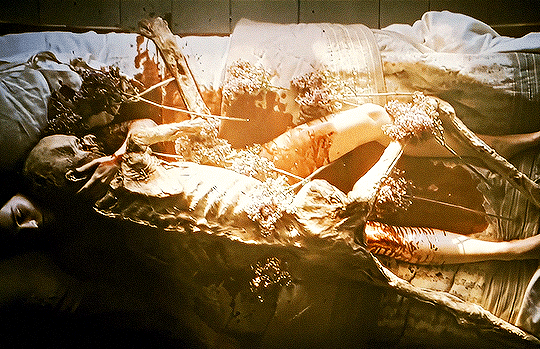

“I believe the dead are at peace: but it is not right to speak of them with levity. […] They are afraid of nothing,’ I grumbled, watching their approach through the window. ‘Together, they would brave Satan and all his legions’.”
Afterwards, the people of the region swore they felt and saw Heathcliff and Catherine’s ghosts in the moors, walking together. Their union after death also brought a new era of harmony and peace to Wuthering Heights. “Redemption!” As Von Franz would say.
Interestingly enough, Von Franz also stares out of the window like the narrator in the final chapter of “Wuthering Heights”; “watching their approach through the window”? He’s also the one who brings and places the lilacs around Ellen and Orlok’s bodies, a tribute to their love.
“And so the maiden fair did offer up her love unto the beast, and with him lay in close embrace until first cockcrow, her willing sacrifice thus broke the curse and freed them from the plague of Nosferatu”.
The majority of people are misunderstanding this passage, because not only this is a Solomanari book (belongs to Orlok) but there is no mention of any “town” or the world in general here. This speaks of how the love and the willing sacrifice (death) of a maiden (Ellen) saved her and the beast (Orlok) from the curse of Nosferatu. “Them” is the maiden and the beast, Ellen and Orlok, and how her love for him and her death saved them both from the curse he had upon himself (Nosferatu). English is not even my mother language and even I can understand this.
As a consequence, her death also saved everyone else, including Thomas (because she loves him too). And so, she exchanges one last look of love with him, silently saying goodbye before departing to the spiritual realm alongside Orlok. So, indeed, Ellen “had her cake and eat it too”, at end, like Catherine; she couldn’t decide between the two men she loved, so she died, but was reunited in death with Heathcliff, and their spiritual union brought peace to “Wuthering Heights”, like Ellen and Orlok’s to Wisburg. While Edgar/Thomas had Catherine/Ellen’s love in life, Heathcliff/Orlok has it in death/spiritual world.
176 notes
·
View notes
Text
I drew a little something for the Hiveworks micro comic summer~

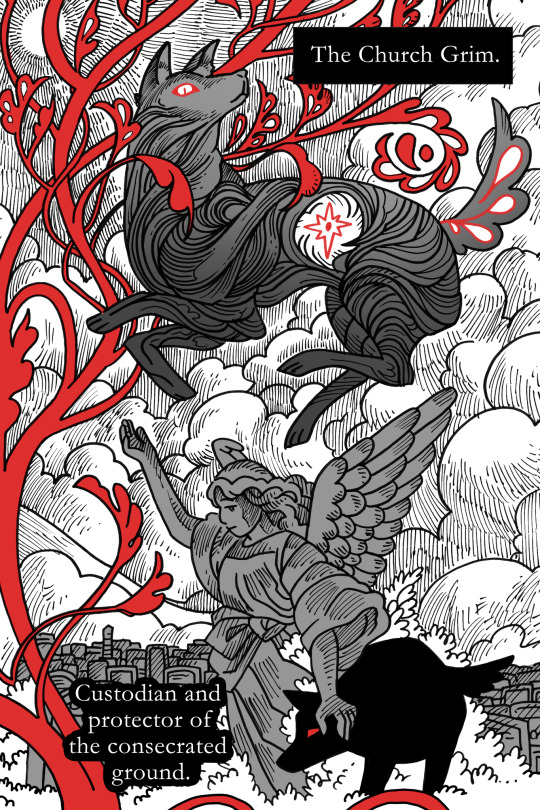

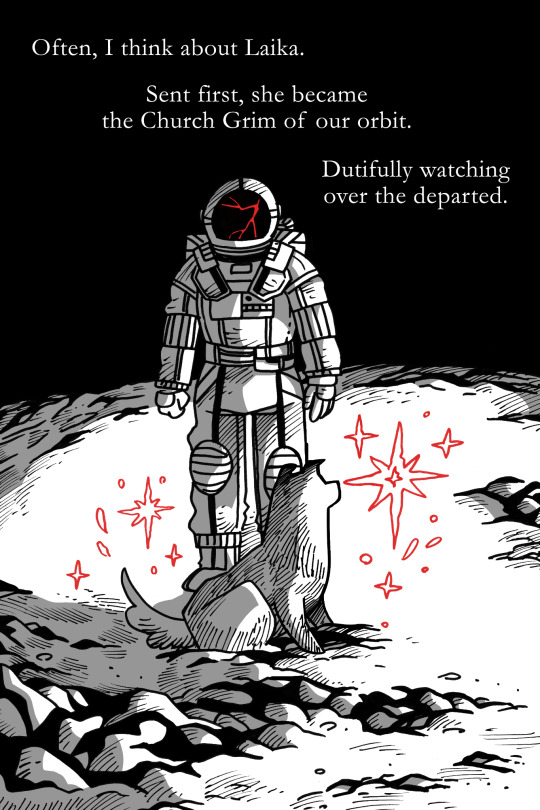
119K notes
·
View notes
Text

If this is in your dashboard you are going to be kissed like that in 2025.
5K notes
·
View notes
Photo
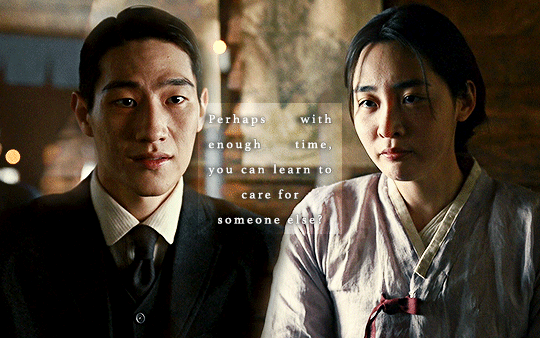


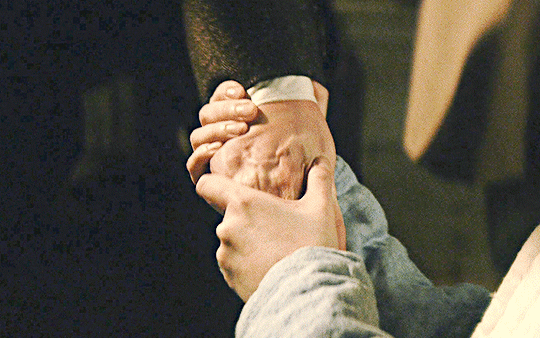
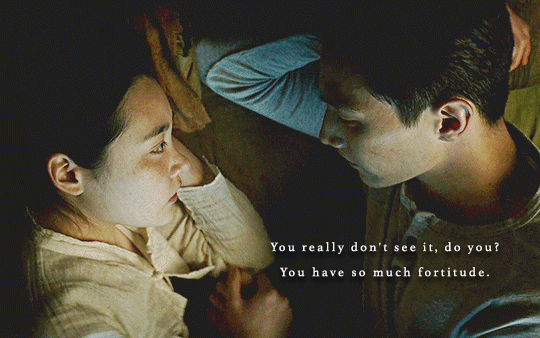

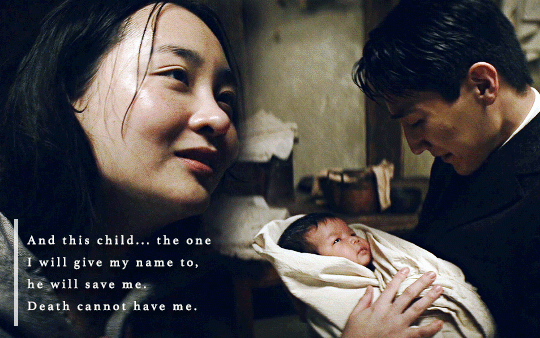
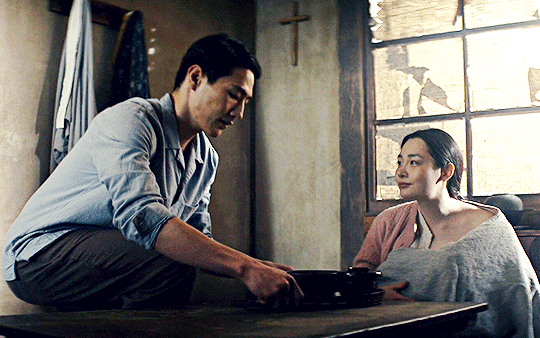
@userdramas event 04: love
Pachinko (2022) - Isak x Sunja
With Sunja, I have this feeling…that perhaps my life can be significant somehow.
586 notes
·
View notes
